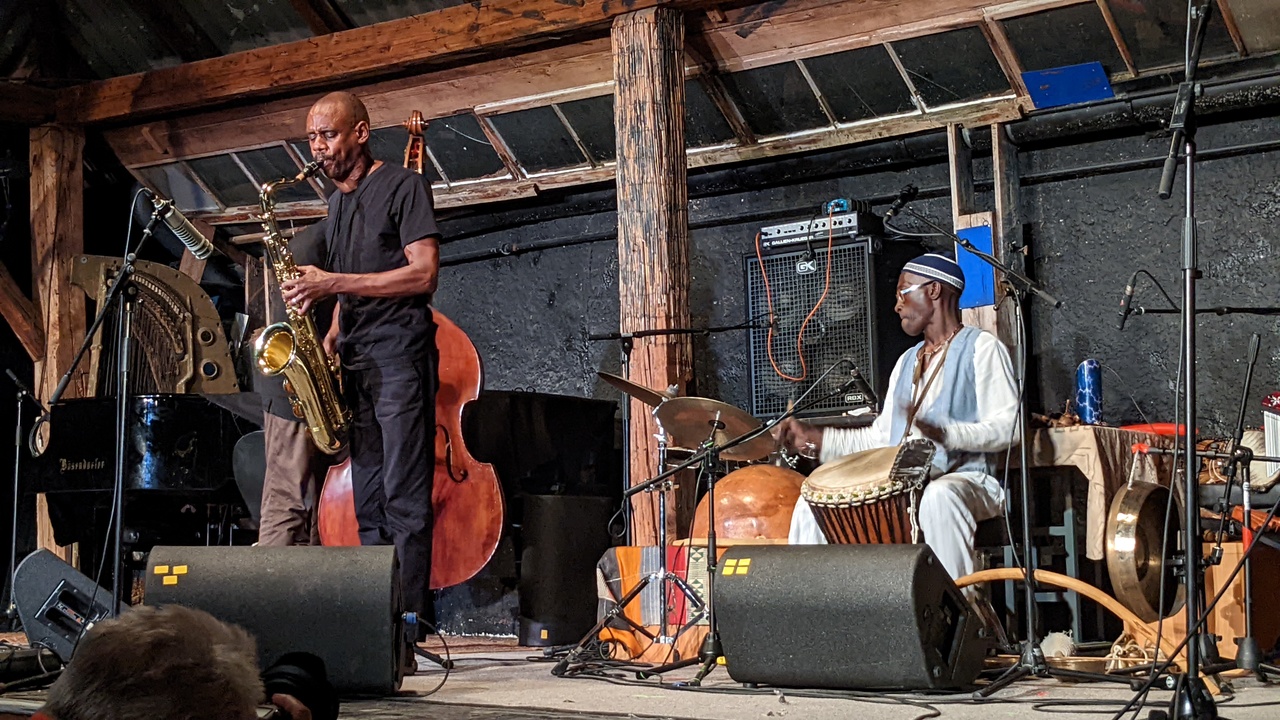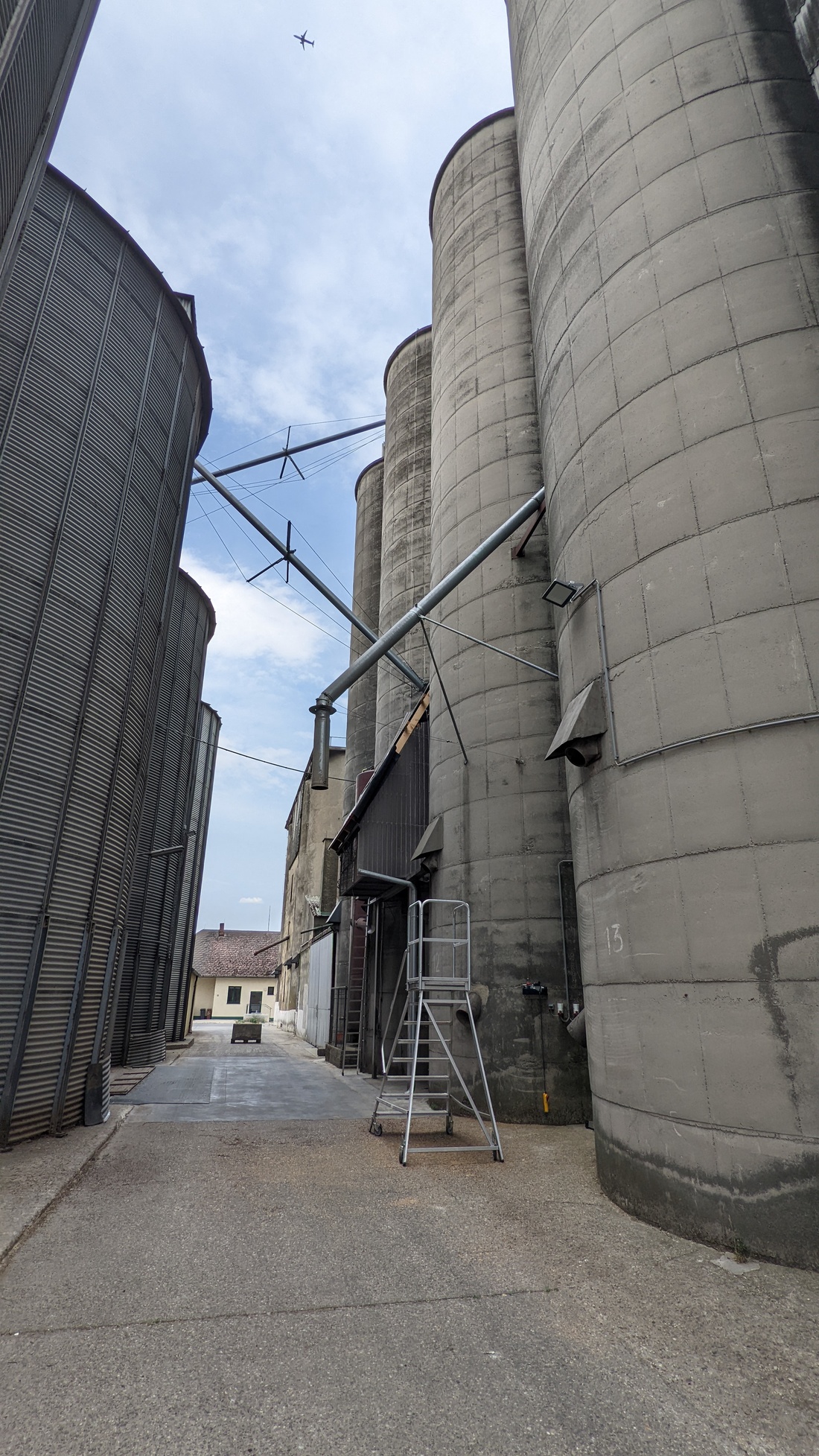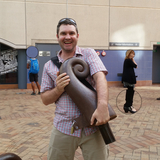“Funny Just Not Jazz Funny”
Seeing MIMEO perform at the Konfrontationen for the second time in 25 years was bittersweet, most directly because Cor Fuhler and Peter Rehberg are no longer with us. But also because Keith Rowe was not invited to participate. When we arrived at the Kleylehof, a light drizzle was underway, so I was surprised that the concert was set up to take place outdoors, given the quantity of electricity in effect. But, as things that are meant to be are meant to be, the drizzle dissipated and the sun shone and the band played two pieces. The first was explicitly dedicated to Rehberg and Fuhler and dubbed “Le Silence et le Vide” and featured Phil Durrant (semi-modular synths), Thomas Lehn (analog synth), Kaffe Matthews (the Ripley, microbrute, ipad), Gert-Jan Prins (electronics, percussion, voice) and Rafael Toral (electronic instruments).
The quantity of abstracted electronic sound that this longstanding group emits feels almost predicated on the notion that you can’t watch them perform and distinguish who is making what sound. Shortly into the performance I felt a shiver of delight when, for a moment, I mistook a squeaky little birdsong above my head for a high-pitched synthesized squiggle. The overall timbre of MIMEO is excessively friendly to my ears: welcoming, relaxing, engaging, curiosity-inducing, frisky-palpitating, romantically-mesmerizing – where tranquilo + pura vida meet and unify. This performance fulfilled all of that, allowing us to sit in the grass and absorb light moving through leaves as circuits heated so sounds could pop. Prins was quite active during this quintet, thumping his chest to transform breath-generated eruptions into unsettled heartbeats, which is how the first piece quieted, and it was easy to hear how hard it was to end a dedication of music to friends with whom you used to play.
For their second piece, Peter van Bergen (computer) and Hans Falb (turntables)––two of the three organizers, along with Gerlinde Koschik, initially responsible for the conception of MIMEO––were added, and this duo got the second piece started with antagonistic aplomb: tinny digitalis from van Bergen and scratchy samplitis from Falb. Toral made his presence the most felt, as he circled the stone coliseum with portable gear (putting the Movement in the Music in Movement Electronic Orchestra) and gave audience members up-close access to both small and large wails, whines, and wriggles. As I mentioned above, I find their music radically pleasant: even when it becomes harsh and aggressive, it is coherent because of the context each member creates. So-called lulls are just as stimulating as overt excitement because the experience of one of their concerts is the experience of testing your own ability to pay attention to a practically infinite amount of stimulus. The concert continued on the shuttle back to the Jazzgalerie as breath, engine, windmill whirr, car clank, and choked hiccup continued to chug along for the six kilometer ride.
The all-important concert that ushers in the night from the day balanced intensity and calm on a knife-edge: Franz Hautzinger (quarter-tone trumpet), Magda Mayas (piano), and Burkhard Stangl (guitar). The assured determination of every move unleashed petal after petal of mellow sanctity. The piano and guitar blended into tender balladry, even if the overall sentiment felt dank and dark. Hautzinger added a little delay and echo with some pedals to his breathy trumpet into which Stangl’s harmonics dissolved as psychedelic-adjacent marbleized swirls.
The entire set held me in a deep layer of concentration, partly because it was so mysterious for so long. The wind was blowing Mayas’ hair, like it also wanted to be playing the piano, which it did, through the dowels she had placed upright in the strings. This largesse of life involved in the making of this music expanded as the reflections of Mayas’ hands––visible in the piano’s angled lid––amplified the sense that the music was much richer, much more voluminous, and many times denser than simply three people on a stage. Forget floating on clouds, the music conjured clouds sinking into water, melting like cotton candy on the tongue. Even when dropped utensils clattered from the kitchen, piano clangs meshed the outside source into a perfect percussive accompaniment. Hautzinger puckered up in front of his trumpet as Mayas tolled bells while rustling inside the piano and Stangl put his ear next to the hole in his guitar to listen even more carefully. “Imagine the lavender,” I heard myself saying silently in the future.
The duo of Emilie Škrijelj (accordion, turntables, electronics) and Tom Malmendier (drums, objects) known as Les Marquises followed. Frenetic and fun, they traded scratches and bashes at a stop/start back-and-forth pace for their first number. Malmendier didn’t stop his attacks long enough for me to discern any rhythmic predilections, but his restrained use of cymbals kept the clashes congenial. Škrijelj’s technique on amplified accordion focused more on vibrating, shaking, and hitting the side of it than any traditional squeeze, producing blurred bass-y wheezes out of the boxed bellows. It was cool, it was fun, it was lightweight after the previous set. Their frenzy resulted in a little more sludge than I prefer to wallow in, but in its own way their mayhem cleaned the aural palette, and the rest of the audience was fervent in their applause, enough to instigate an encore.
Speaking of clapping, it had felt anxious and even aggressive at a few other moments during the festival, notably for MIMEO and Hautzinger/ Mayas/ Stangl, acts for which a little more breathing room was warranted. The applause as Black Top was taking the stage was initially energetic, and there was no way I going to let it falter before Pat Thomas (piano, electronics) was fully in place, as I consider his huge musical career heroic. Orphy Robinson (vibes), Hamid Drake (drums), and Luke Stewart (bass) rounded out the lineup for this iteration of the ever-expanding Black Top project by Thomas and Robinson. William Parker was originally scheduled to perform, and is fine now, but he had just recently had a health scare while on tour with Drake, who spoke about him and beseeched healing energy in his direction before the set started. I didn’t expect a digital sound to be the first one heard after Drake’s words, but Thomas is an apropos trickster, and the one-step-removedness of a thin electronic sample actually invoked Parker’s presence in a snugly fitting way.
As it happened, I sat behind a pole that completely blocked Stewart from my view, and his music fused so seamlessly into the ever-abounding rhythms that it felt like Parker was there, and that Parker’s contributions to the legacy of the music––ably embodied by Stewart––will be burning with us longly. I could also see Bogdana dancing out of the right corner of my field of vision, always a blessing to an ambience. Another heart-charmingly visual element was a young girl nervously approaching the stage with her digital camera to get a picture of Drake, clearly a hero.
Musically, the whole set was achingly exalted. Mind-meltingly subtle changes were instantly recognized by each member of the quartet, fueling flows from solo to chorus to transitional electronics to a drum roll from Drake and then…boom!: they’re all hitting the sweet side of a gargantuan beat and teasing out exquisite filigrees of harmonic texture. Stewart initiated one passage of sultry funk and another of delicate softness, helping demonstrate just how deftly these musicians connect. With so much sound to absorb on so many levels, I had to sit back and be thankful that the whole immensity of the music was passing through us all, grateful that aspects we will never consciously understand will be in our cells forevermore. They ended as a light rain started to fall, just like how the day began.





